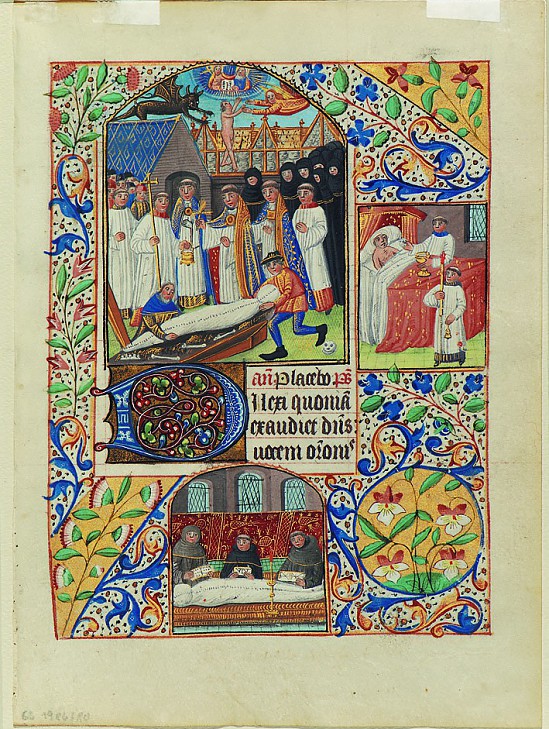Ein Stundenblatt „Placebo domino in regione …“
probably Northern France, c. 1480; miniature paintings, polychrome, 21.2x15.5 cm, GS 1986/80
This is a page from a book of hours. Books of Hours were prayer and devotional books for the prayer of the hours and came up in the 13th century. The present copy is from the heyday of the Book of Hours, the 15th century. The miniature paintings provide insights into the burial practices of the time. The small picture on the right shows a man lying on his deathbed, to whom two clergymen - brothers of the order - administer the last sacraments. In the lower picture the Office of the Dead is performed by brothers of the order, for which the deceased was laid out and sewn into a cloth. The main picture above is dedicated to his burial or burial chamber. It is presided over by several clergymen of the congregation, dressed in white liturgical vestments. Two gravediggers lift the deceased out of the coffin to bed him in his grave. It is conspicuous that the coffin was thus only used as a means of transport. The reason is that burials in the coffin were by no means obligatory per se at the time. In addition, there were sometimes purely external circumstances that spoke against the use of coffins as burial objects, including a shortage of wood or the need to speed up the decomposition process due to lack of space in cemeteries. The use of a coffin only became compulsory in the 19th century.
Nevertheless, the main picture shows another interesting detail. In the left background a group of people dressed in uniform black can be seen, probably a so-called funeral brotherhood. In this case they are recruited from the already mentioned religious community. Such a spiritual fraternity had to take care of the salvation of deceased members of the fraternity. That is, they made intercession, which usually followed a strict canon of rules and included the holding of prayers and masses. All three images are flanked by vegetal borders and form around Psalm 116,9 (AT): "Placebo domino in regione vivorum", the translation of which reads: "I will please the Lord in the land of the living". Moreover, it is important to recognize that the images reflect a so-called work of mercy. In early Christian times a canon of Christian virtuous actions had developed, which formed the Seven Works of Mercy - the seventh work reads: Burying the dead.

Arbeitsgemeinschaft Friedhof und Denkmal e.V.
Zentralinstitut für Sepulkralkultur
Museum für Sepulkralkultur
Weinbergstraße 25–27
D-34117 Kassel | Germany
Tel. +49 (0)561 918 93-0
info@sepulkralmuseum.de








